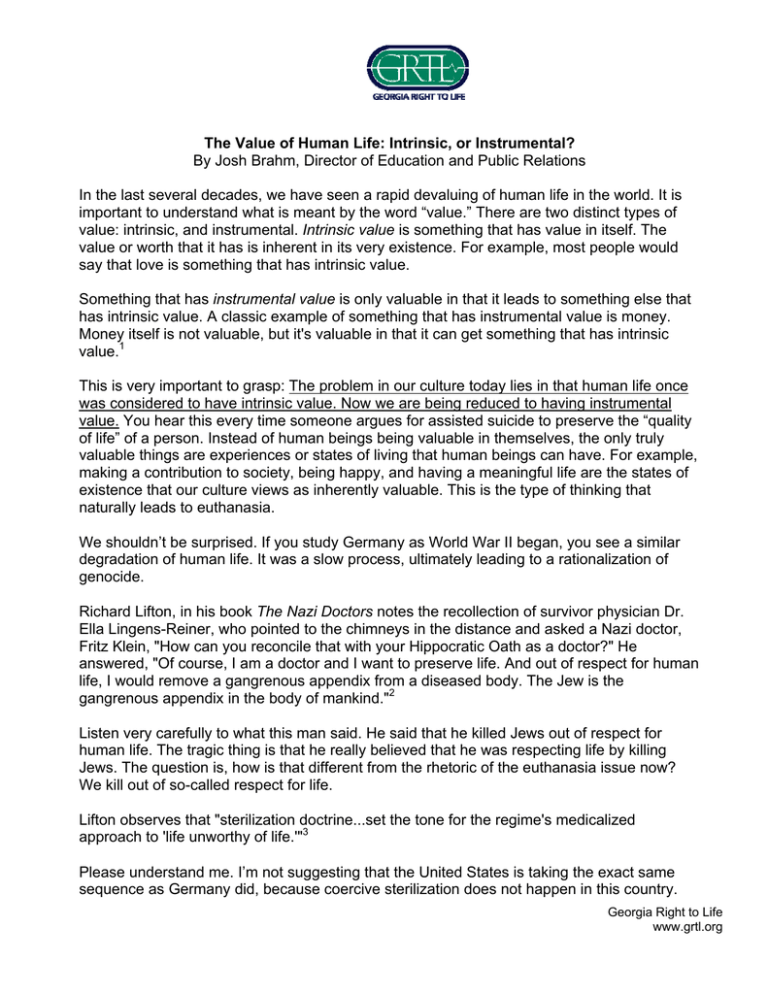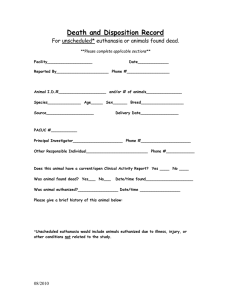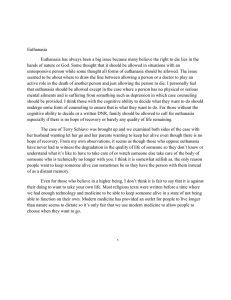The Value of Human Life: Intrinsic, or Instrumental? By Josh Brahm
advertisement

The Value of Human Life: Intrinsic, or Instrumental? By Josh Brahm, Director of Education and Public Relations In the last several decades, we have seen a rapid devaluing of human life in the world. It is important to understand what is meant by the word “value.” There are two distinct types of value: intrinsic, and instrumental. Intrinsic value is something that has value in itself. The value or worth that it has is inherent in its very existence. For example, most people would say that love is something that has intrinsic value. Something that has instrumental value is only valuable in that it leads to something else that has intrinsic value. A classic example of something that has instrumental value is money. Money itself is not valuable, but it's valuable in that it can get something that has intrinsic value.1 This is very important to grasp: The problem in our culture today lies in that human life once was considered to have intrinsic value. Now we are being reduced to having instrumental value. You hear this every time someone argues for assisted suicide to preserve the “quality of life” of a person. Instead of human beings being valuable in themselves, the only truly valuable things are experiences or states of living that human beings can have. For example, making a contribution to society, being happy, and having a meaningful life are the states of existence that our culture views as inherently valuable. This is the type of thinking that naturally leads to euthanasia. We shouldn’t be surprised. If you study Germany as World War II began, you see a similar degradation of human life. It was a slow process, ultimately leading to a rationalization of genocide. Richard Lifton, in his book The Nazi Doctors notes the recollection of survivor physician Dr. Ella Lingens-Reiner, who pointed to the chimneys in the distance and asked a Nazi doctor, Fritz Klein, "How can you reconcile that with your Hippocratic Oath as a doctor?" He answered, "Of course, I am a doctor and I want to preserve life. And out of respect for human life, I would remove a gangrenous appendix from a diseased body. The Jew is the gangrenous appendix in the body of mankind."2 Listen very carefully to what this man said. He said that he killed Jews out of respect for human life. The tragic thing is that he really believed that he was respecting life by killing Jews. The question is, how is that different from the rhetoric of the euthanasia issue now? We kill out of so-called respect for life. Lifton observes that "sterilization doctrine...set the tone for the regime's medicalized approach to 'life unworthy of life.'"3 Please understand me. I’m not suggesting that the United States is taking the exact same sequence as Germany did, because coercive sterilization does not happen in this country. Georgia Right to Life www.grtl.org Planned Parenthood does encourage forced sterilization in its population control programs in other countries, but they don’t do that in America… yet.4 I think we are seeing a similar sequence of events however, because while we don’t have sterilization, we have something else that fits the bill: abortion. Just as sterilization in Germany was viewed as a healing act, abortions are considered “therapeutic.” The difference is that abortion is not meant to single out the genetically undesirable, but rather the merely unwanted. Even so, both seem to be the first step that lay the philosophic foundation for the steps that follow. For the Nazis, sterilization was the first step that led to killing impaired children and then killing impaired adults. In our culture, abortion has served that function because clearly since 1973 we have moved towards the unofficial, though widespread, killing of impaired children and now the attempt to legalize the killing of impaired adults, though unofficially that is going on. It’s even worse when you consider euthanasia in the Netherlands. Since euthanasia and assisted suicide became legal in 2001, this is how far it’s come: ¾ Euthanasia has expanded to infants, the depressed, and the chronically ill.5 ¾ Children as young as 12 with parental consent and those as young as 16 with parental notification can access euthanasia.6 ¾ The percentage of deaths from euthanasia has continued to increase.7 ¾ 80% of euthanasia deaths are not requested by the patient.8 ¾ Virtually every guideline set up by the Dutch has failed to protect patients or has been modified or violated.9 This is the direction our country is headed. We truly are running out of time to turn this “culture of death” around. Please join us by educating those in your own sphere of influence on the intrinsic value of human life. Sources: 1: Koukl, Gregory. “The Nazi Doctors,” http://www.str.org/site/News2?page=NewsArticle&id=5658 2: Lifton, Richard. The Nazi Doctors. Basic Books, 1986, p. 16 3: Lifton, Richard. The Nazi Doctors. Basic Books, 1986, p. 25 4: Glasow, Richard D., Ph. D., Ideology Compels Fervid PPFA Abortion Advocacy. National Right to Life News, March 28, 1985 5: Herbert Hendin MD, Chris Rutenfrans PHD and Zbigniew Zylicz MD. Physician-Assisted Suicide and Euthanasia in the Netherlands. JAMA, June 4, 1997 vol. 277, No 21, p. 1720 6: Associated Press, Reuters, BBC, Nov 28, 2000 7: Herbert Hendin MD, Chris Rutenfrans PHD and Zbigniew Zylicz MD. Physician-Assisted Suicide and Euthanasia in the Netherlands. JAMA, June 4, 1997 vol. 277, No 21, p. 1720 Georgia Right to Life www.grtl.org 8: Herbert Hendin MD, Chris Rutenfrans PHD and Zbigniew Zylicz MD. Physician-Assisted Suicide and Euthanasia in the Netherlands. JAMA, June 4, 1997 vol. 277, No 21, p. 1721 9: Daley, Suzanne. The Dutch Seek to Legalize Long-Tolerated Euthanasia. New York Times, June 20, 2000, p.A10 Georgia Right to Life www.grtl.org

